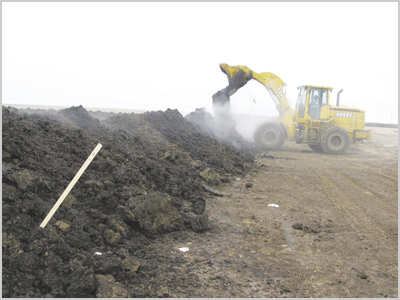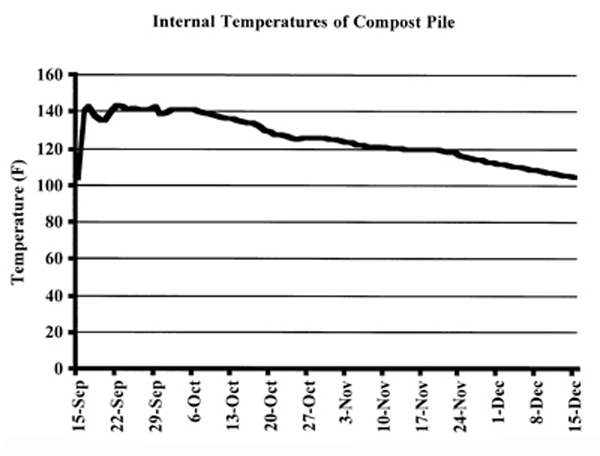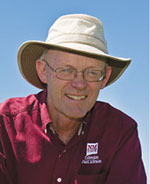Whole Animal Composting of Dairy Cattle
Guide D-108
Revised by Robert P. Flynn and Robert G. Hagevoort
College of Agricultural, Consumer and Environmental Sciences, New Mexico State University
Authors: Respectively, Extension Agronomist and Extension Dairy Specialist, Department of Extension Plant Sciences, New Mexico State University. (Print Friendly PDF)
Introduction
Even the most well-managed dairy operations experience animal losses each year due to weather, natural causes, and/or illness. New Mexico dairy farms have the option to have rendering services pick up the mortalities or, alternatively, may compost them on the dairy premises. The abundance of stockpiled manure and old feedstuffs on dairy operations makes whole animal composting a feasible alternative to carcass removal (Figure 1). It is not acceptable in any situation to abandon carcasses in open pits, ditches, abandoned wells, sinkholes, or water features. The objectives of this publication are to outline factors that affect proper composting procedures and discuss how to compost animal carcasses on the dairy.

Figure 1. Whole animal composting can be a successful, environmentally safe, and economically feasible method to dispose of carcasses.
Composting Basics
Composting is the controlled aerobic decomposition of organic material by microbial communities to form a more homogenous, fine-particle, humus-like product. The material that the carcass will be placed in should have optimal conditions that favor microbial activity to help decompose the carcass.
Sawdust is the preferred carbon source due to its highly absorbent characteristics and ability to make contact with the carcass. However, other sources of carbon can achieve the desired results. The compost mixture's moisture content should be 50 to 60%. Moisture contents greater than 60% will generate odors and increase the chance of leachate (runoff) from the compost pile. Follow this general rule of thumb: If the mixture feels moist but no water drips from a handful when squeezed, the moisture level is adequate.
To ensure aeration of the compost pile, particle size of composting materials should range between 1/8 and 1/2 inch in diameter. Proper particle size increases the pile's porosity (air space), which allows air to enter to maintain oxygen concentrations for optimal microbial growth. Aeration by turning also introduces air into the compost pile, but this will not be done for the first 6 months of mortality composting. Optimal mortality composting occurs when core temperatures are between 120 and 150°F.
How To Compost Whole Cow Carcasses
Contrary to popular belief and practice, simply covering carcasses in manure is not considered composting. Generally, an animal carcass is a mass with a low carbon-to-nitrogen (C:N) ratio (that is, high nitrogen levels with relatively low carbon), high moisture content, and virtually no air. Consequently, compost materials must have high C:N ratios, moderate moisture, and satisfactory porosity for aeration. Proper composting consists of layering the carcasses with composting materials in a static pile until the soft carcass tissue has fully decomposed.
Site selection is important to the overall success of composting. The composting pile should be located to allow easy access, minimal travel, and convenient handling of manure and straw/old feedstuffs, and it should be a proper distance and downstream from live cattle. Sites near neighbors and water sources or streams should be avoided. Mortalities should not be visible from roads or by neighbors and should have enough distance from them to not create a nuisance. Make certain that surface runoff and other pollution controls can be implemented at the site. Good drainage of the compost pile is also necessary to prevent water from pooling. There should be access to water as well. Ideal slope should be 1 to 3% for proper drainage. The composting pad should be firm but does not need to be paved. Sand, gravel, or caliche at a depth of 6 inches is desirable if current soil conditions are not acceptable. Avoid incorporating the pad material into the composting material.
If for some reason composting must occur in a location with a shallow water table, extra measures are necessary. For small composting piles, first lay down a 6-mm-thick 10 × 12 feet plastic sheet before building the composting pile. For larger operations where tractors, loaders, and other equipment will be working the compost pile, establish a packed pad over the composting area and top the pad with an absorbent organic layer in addition to the layer that will be laid as a base for the actual compost pile.
If a shallow water table is not an issue, start with a base that is at least 9 feet wide by 10 feet long along with a 12- to 24-inch-deep layer of an absorbent, bulky material, such as wood chips (4—6 inches in length), dry and porous manure, compost, sawdust with large particle size, manure mixed with straw, old feedstuffs, or other material that does not easily compact. Save time by having an area of base material constructed to accept mortalities.
The mortality can then be placed on the base material. Lay the carcass on its side on the middle of the base material. Open the body cavity and, for cattle, puncture the rumen. This is done to prevent bloating and bursting, which could displace the compost cover and lead to nuisances. Once the mortality is properly laid, the cover can be moved into place.
Next, place 12 to 24 inches of cover material directly around the mortality. This material should be easily compostable. This layer does not need to be as coarse as the base layer and can be material that has an odor itself. Manure, waste silage, and other low C:N materials are ideal for the area directly above and around the carcass. When using manure next to the carcass, a 50:50 ratio of manure and a carbon source is generally recommended. Manure screenings from solids separators are excellent for composting, especially when mixed with manure. Screenings, however, tend to compact and would not be a favorable base material. If the material's moisture content is less than 50 to 60% (holds together when squeezed) then water should be added.
Finally, completely cover the carcass with 8 to 12 inches of manure, compost, or screenings that are 50 to 60% moisture. There should be at least 18 to 24 inches of organic material covering the mortality; additional material won't hurt the process. This layer helps insulate the compost for good temperature control and helps absorb odors. Most dairy mortality compost piles or windrows are approximately 6 feet high. The total estimated material needed to fully compost a full-grown cow is 12 cubic yards.
The pile's internal temperature should be monitored for the first few months of composting using a long-stem thermometer placed 2.5 to 3 feet into the pile. The core temperature should reach 120 to 150°F within the first week of composting. The closer to 150°F the better for weed seed destruction. Pathogens require at least 131°F for 72 hours in order to be destroyed. Proper pile construction will result in unbalanced C:N ratios, variable moisture content, and pockets of anaerobic decomposition, which also causes changes in temperature. Check the pile in several locations to be sure temperatures are rising after construction. Temperatures above 160°F will stop microbial activity, and composting will be greatly reduced.
It is best to leave the pile untouched for 4 to 6 months when properly constructed. Longer times may be warranted before opening the pile to aerate and moisten it before allowing the composting to continue for another 2 to 4 months (Figure 2). Make certain carcasses remain fully covered after turning. Large square hay bales can be placed around the pile's perimeter to protect from pests and can help reduce the amount of material needed to add around the compost. Furthermore, if there is runoff from the compost pile, the hay will act as an absorbent. Decomposition of a mature dairy cow carcass generally takes 6 to 8 months. A few small bones will remain, and they will be soft and shatter easily when passed through a manure spreader during land application. The compost should be used onsite and not sold. A C:N ratio and nutrient analysis of the final product can help determine application rates to reduce fertilizer costs.

Figure 2. When internal temperatures fall below 145°F, the pile can be turned using a windrow turner or front-end loader.
Bovine Composting Experiment In New Mexico
Twelve cow carcasses were used to initiate whole animal composting on a large (approximately 3,000 lactating cows) southern New Mexico dairy operation. Compost pile construction was established by spreading a sand/manure mixture on a level site to a depth of approximately 10 to 12 inches. A single carcass was then placed on the mixture and covered with the compost mixture to a depth of 18 to 24 inches; a similar technique was used to cover each carcass. Dimensions of the final pile were 14 to 15 feet wide and 6 feet high. A temperature data logger was placed 2 feet into the pile to record internal temperatures. Rainfall totaled 2 inches at the dairy during the experiment, and no additional moisture was added. Samples of composting materials were collected prior to (Table 1) and after (Table 2) composting cows to determine changes in nitrogen, phosphorus, carbon, dry matter, and pH. Carcasses were uncovered at 2 and 4 months to determine time needed to decompose cows. Compost pile temperatures reached a high of 142°F approximately 3 days after pile establishment (Figure 3). At 2 months, carcasses were 60 to 65% decomposed. The bones were clean, and the flesh was 90% decomposed. After 4 months, carcasses were somewhat difficult to find with only several small bones (7 to 10 bones/carcass) remaining. The C:N ratio was 12:1 prior to composting and 11:1 after composting. Carbon and nitrogen percentages were reduced by approximately half after composting. It should be noted that the pile was not aerated nor were other carbon sources added. The goal was to mimic what would actually take place on a dairy operation. It is obvious from this study that the addition of moisture, aeration, and other carbon sources would have decreased composting time, but would have increased dairy producers' labor and cost.
Table 1. Composting Mixture Analyses Prior to Composting
| Measure | Sample 1 | Sample 2 | Sample 3 | Average |
| Carbon (%) | 42.8 | 47.8 | 43.8 | 44.8 |
| Nitrogen (%) | 4.2 | 3.4 | NT | 3.8 |
| C:N | 10:1 | 14:1 | NT | 12:1 |
| Phosphorus (%) | 0.01 | 0.01 | NT | 0.01 |
| Dry matter | 19.4 | 25.4 | 21.7 |
22.2
|
| pH | 8.5 | 8.4 | 8.0 |
8.3
|
| NT: Not tested | ||||
Table 2. Composting Mixture Analyses After Animal Composting
| Measure | Sample 1 | Sample 2 | Sample 3 | Average |
| Carbon (%) | 17.9 | 18.1 | 28.9 | 21.6 |
| Nitrogen (%) | 2.3 | 1.3 | 2.3 | 2.0 |
| C:N | 8:1 | 14:1 | 13:1 | 11:1 |
| Phosphorus (%) | 0.01 | 0.01 | 0.04 | 0.02 |
| Dry matter | 40.4 | 47.5 | 51.4 | 46.4 |
| pH | 8.6 | 8.7 | 8.2 | 8.5 |

Figure 3. Compost pile temperatures reached a high of 142°F.
Summary
By following a few general composting recommendations, whole animal composting can be a successful, environmentally safe, and economically feasible method for disposing on-farm carcasses. Cost of whole animal composting, which includes a synthetic liner (if used), is estimated to be approximately $4 per carcass. Remember, composting procedures are not absolute and are somewhat forgiving. Trial and error accompanied by close monitoring of pile characteristics will usually produce successful results. Before implementing whole animal composting on your dairy, check local and state requirements regulating animal carcass disposal. The biological process of composting animal carcasses is similar to the processes of composting other organic materials. Carcass compost is an excellent source of fertilizer for crops used by the dairy farm. However, the compost generated from decomposed animal carcasses should not be given away or sold as compost for off-farm use.
Original author: Michael Looper, Extension Dairy Specialist.
References and Additional Reading
Bass, T., D. Colburn, J. Davis, J. Deering, M. Fisher, R. Flynn, S. Lupis, J. Norton, and N. Schauermann. 2011. Livestock mortality composting for large and small operations in the semi-arid West [EB0205; online]. Available from https://msuextension.org/publications/AgandNaturalResources/EB0205.pdf
Bagley, C.V., J.H. Kirk, and K. Farrell-Poe. 1999. Cow mortality disposal [Extension Publication AG-507]. Logan: Utah State University Cooperative Extension Service.
Dougherty, M. (Ed.). 1999. Field guide to on-farm composting [NRAES-114]. Ithaca, NY: Cornell University Cooperative Extension.
Rynk, R. (Ed.). 1992. On-farm composting handbook [NRAES-54]. Ithaca, NY: Cornell University Cooperative Extension.
The Ohio State University. 2006. Ohio's livestock and poultry mortality composting manual. Columbus, OH: Author.
Trinca, L.A., B. Miller, and F.R. Beard. 1999. Bovine mortality composting in northern Utah. Presented at 1999 ASAE/CSAE-SCGR Annual International Meeting, Toronto. July 18-21, 1999.

Robert Flynn is an Associate Professor of Agronomy and Soils and an Extension Agronomist at New Mexico State University. He earned his Ph.D. at Auburn University. His research and Extension efforts aim to improve grower options that lead to sustainable production through improved soil quality, water use efficiency, and crop performance.
To find more resources for your business, home, or family, visit the College of Agricultural, Consumer and Environmental Sciences on the World Wide Web at pubs.nmsu.edu
Contents of publications may be freely reproduced for educational purposes. All other rights reserved. For permission to use publications for other purposes, contact pubs@nmsu.edu or the authors listed on the publication.
New Mexico State University is an equal opportunity/affirmative action employer and educator. NMSU and the U.S. Department of Agriculture cooperating.
Revised and electronically published August 2013 Las Cruces, NM


